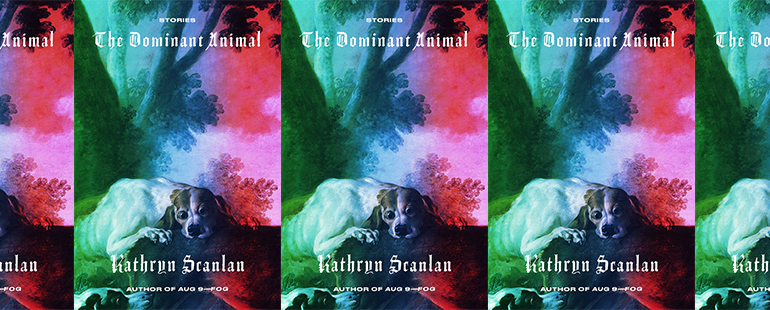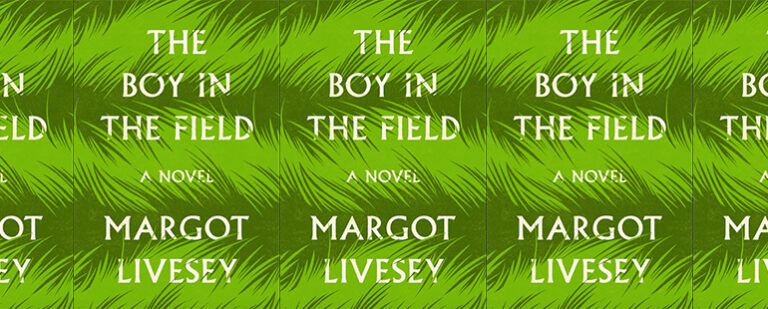“I think writers should write exactly as they please”: An Interview with Kathryn Scanlan

The forty stories that make up Kathryn Scanlan’s The Dominant Animal are tiny, beautifully encapsulated enigmas and language riddles. They are ferocious packets of energy and precise phrasing, created not to be solved—they have no solution—but to mull, to unwind, to savor. Scanlan wastes no words, holds no hands, and stretches our capacity for combinations of words and bouts of plot. The Dominant Animal is a collection refined in its stance and set to re-define the abilities of a short story.
Released last summer, Scanlan’s debut work, Aug 9—Fog, is not a novel or a short story collection or a poem or a collection of poems. It is a linguistic investigation of being and not. Based on a diary Scanlan purchased at an estate auction fifteen years prior, Aug 9—Fog is a book Scanlan spent more than a decade working and reworking, using the original diary content to craft new sentences and layers of meaning, unraveling a book from someone else’s words. In it, we see Scanlan looking at the world in a wholly different way—not to simply tell a story, to weave tales from invention, but to insist on additional layers of significance and depth and beauty, making meaning between someone long gone and herself, and passing that journey on to the reader for our interpretations and personal emotional resonance. This insistence on challenging norms and wreaking a bit of havoc on conventional linguistic approaches and storytelling expectations is evident, too, in The Dominant Animal, only this time it is done solely in Scanlan’s own hand.
One element that plays across the entire collection is the presence of animals, many of whom function as both secondary characters and prime catalysts. From dogs to birds, animals embedded in these stories often help show what is beyond the human skin. In “Shh,” for instance, a wealthy surgeon first relays his involvement with animals, demonstrating his privilege, by sharing how pampered his own dogs are. They are a pair of purebreds who “ate top-shelf meat, delivered daily and ground by hand by the housekeeper.” His wife rescues horses “doomed as glue—to keep as pets,” and when a neighbor complains of the moles ruining his yard, the surgeon pushes, again with privilege: “live and let live, Al—what’s so bad about a few lumps in the grass?” But when mice get into the surgeon’s garage and begin ruining his fancy car collection, Scanlan shows us the fragile nature of the character’s beliefs in the face of accumulated possessions, the surgeon backtracking on his values when he sets up glue traps. The narrator, a patient being prepped for a procedure under the surgeon’s care, asks of the story about the mice and the garage, “Did it work? I said. Did you save them? A nurse fitted a mask on my face. Someone turned on the gas.” Scanlan crafts a beautiful parallel between the characters and the animals: like the mice stuck on the glue traps, the patient, nearly anesthetized, awaits the surgeon’s blade. “Well, no, he said. The first one I tried, I sliced off its foot instead. There was a lot of blood, actually. It was terrible, he said.” In a final linguistic pop, Scanlan gives us the patient’s thought: “I opened my mouth, but only a little squeak came out.”
Scanlan also makes deft use of brevity, especially in service of under-plotting, in letting the story unfold without narrative overload. “Ta-Da!” follows a narrator walking through a neighborhood soundscape, carrying us through a chronology of life in the span of a single page. Beginning with a child who quickly becomes a man, the narrator notices that “a child was talking, or trying to, on the other side of the garden fence, yet the child did not sound like a child. This must be a man, I thought—a sad, tired, sloppy drunk of a certain age, attempting to express his disappointment with life.” From there we are walked immediately into sexual awakening, followed by middle age indicators: “But when I looked up, I saw that the man held a saw, and that the sexual sounds were the sounds of a saw’s blade cutting the wet orange flesh of a tree. As I walked away, the noise changed again—this time becoming the comical splutter of several forceful farts.” Finally, we’re taken into dreams of lost limbs and shaded hills, the portending of age and nightmares of death: “I was reminded of a dream I have from time to time, wherein a German shepherd tears off an arm of mine.” All of this happens in the briefest narrative, which culminates in a brilliant looping back with its last sentence: “I’ve always been a sucker for origin stories, so I held my breath and waited to see how this one might begin.” The reader must make the leaps, cross the gaps, flesh out the story. It isn’t that Scanlon has left us high and dry, only that she pushes our reading experience into new territory, expecting more of us as an audience and getting us there with her use of brevity.
Beyond the sparse and tightly-woven use of language, Scanlan also gives us a grossly engaging look at the theme of dominance and the struggle for power. The story “Florida is for Lovers” opens with direct conflict: “My parents wanted me out from the start.” Even when the narrator is grown and leaving home, the idea of dominance is handed to her in her father’s parting gift of two caged birds: “The smaller, uglier bird was the male. He tormented the female—unless she liked that kind of thing.” This idea—is it torment, or is it a specific kind of love?—is mirrored in the ending of the story; likewise, the eventual death of the female bird is echoed by the death of the narrator’s parents. After she returns to her apartment after cleaning out her family home, this yearning for power and dominance is invoked as her roommate enters the scene: “He came up behind me and put his hands on my neck. I’ve just robbed a place, I said. Looks like there wasn’t much to take, he said, squeezing me in a way I’d come—after many years of failed attempts—to enjoy.” In all of this—animals paralleling human character arcs, an intricate yet minimally explained plot, and a sharp focus on dominance—Scanlan is challenging our norms and pushing our boundaries, making a story do more than perhaps we previously thought possible.
I recently spoke with her about finding inspiration in the natural world, who she writes for, and the origin of the themes at hand in her work.
J.A. Tyler: So great to talk with you about The Dominant Animal, a collection loaded with short-short stories and beautiful, deep language. First things first, from the title through many of the pieces, animals are present—dogs and birds in particular—and they are often as important as the human characters. What inspiration or literary power do you find in animals?
Kathryn Scanlan: It’s a privilege and a delight to observe animals, what they do, how they live. The joy of it is partly due to a sense of proximity to mystery. I’m motivated by the energy and nonverbal communication offered to us by animals—also trees, plants, weather, objects.
JAT: As an observer of the natural world, how do you find it communicates its way into writing? When you’re among animals or plants or weather or even objects, do the words immediately start coming to you, or is it in retrospect that you begin hearing and building upon their mysteries?
KS: I think it’s a matter of ongoing surveillance, with images or feelings preserved like photographs, which are later brought up for review and translation into language. But sometimes words present themselves at the start.
JAT: These stories are very brief, most covering less than three pages and some only a half a page. What draws you to this length of story? What benefits does it afford?
KS: I’m never intending to write a story of a specific length when I begin. Mine come out the way they do because I try to write with maximum tension and minimum explanation. I try to write a story with no point at which a reader—myself or someone else—loses interest.
JAT: Some authors over-explain for fear of losing the reader, not in terms of engagement but in terms of narrative clarity. Do you ever have those fears? What kind of allegiance, if any, do you think authors owe or have to the reader in terms of explanation versus mystery?
KS: I write stories I want to read. Second-guessing my instinct to accommodate a hypothetical reader is not something I’m interested in doing. I don’t understand the idea that a book should go out of its way to make a reader comfortable. Isn’t this pandering? Isn’t this an insult to a reader’s intelligence? If writers owe anything to a reader, it’s to assume a reader is intelligent and perceptive. I think writers should write exactly as they please.
JAT: As with the titular story “The Dominant Animal,” as well as several others, there is a core focus on power struggles. Assuming this happened organically, one story at a time, what draws you to writing about opposing forces and issues of dominance?
KS: These are the themes of my life and the issues I’ve seen replicated ad nauseam in the lives of friends and family and strangers. Writing about them is a way to transform my anger and sense of injustice and discomfort with my own culpability into creative energy.
JAT: Does transforming that anger and sense of injustice and discomfort into creative energy have a psychological or even a physical result on you? How well does writing about it mitigate that feeling of culpability?
KS: I don’t know that I’d call it cathartic, if that’s what you mean. But I think energy is energy, and it’s possible to put it to creative or destructive use. When I don’t put it to creative use, it damages my body and psyche.
JAT: What author most invigorates you, and what is it about their work that energizes your own?
KS: I like a lot of different work but there’s a magical quality some work has that activates me to make my own. This work is usually preoccupied with maximizing language’s potential, but there’s something else to it, something about the mind and spirit of the person who wrote it, an energy that gets conveyed. Moyra Davey talks about this in “The Problem of Reading”—she asks, “what if the most gratifying reading is the one that also entails the risks of producing a text of one’s own?”—and the remarkable thing about her essay is that it describes this feeling while simultaneously producing it in me as a reader. I’ve said it elsewhere, but the work of Diane Williams reliably has this effect on me, and so does the work of the writers she publishes in NOON.
JAT: As a meticulous writer, one who pays attention to every single word, I’m curious: what is your favorite word? And what are some of your least favorites?
KS: I like all the words, even the bad ones. I think you can find a place for all of them—it’s a matter of context. When a word seems bad, I think it’s usually because it’s being used in a tired or squeamish way.


